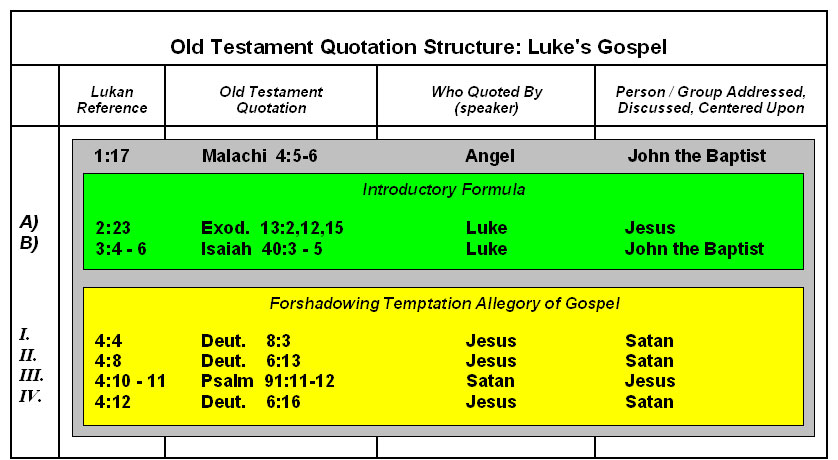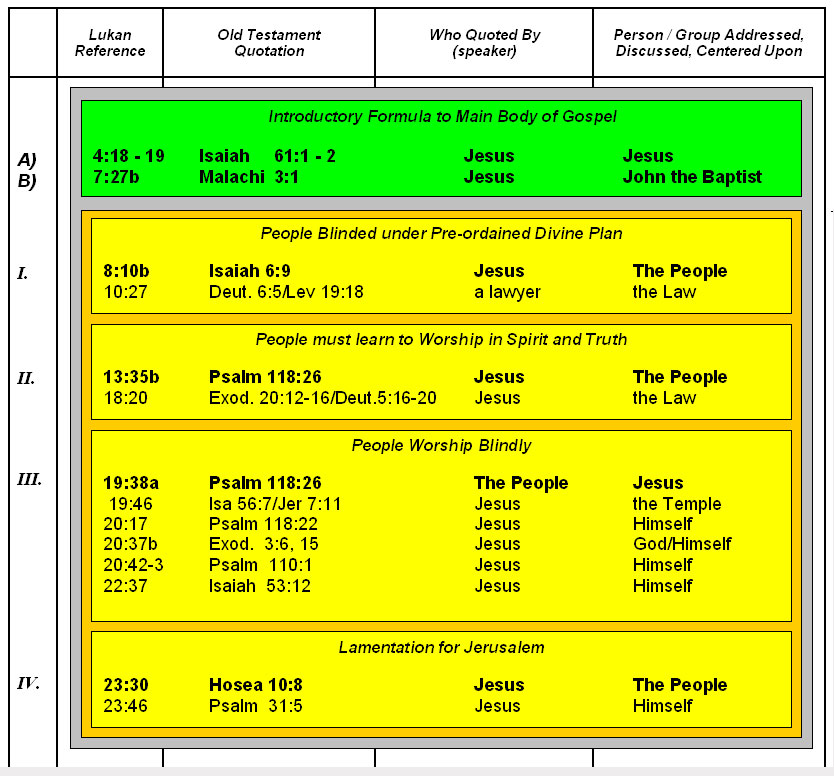Page Index
Last Updated: Apr 24, 2009
INTRODUCTION
O.T. Quotation Structure - Luke
The first thing that jumps out at us when viewing Luke's use of the O.T., is the remarkable Exchange between Jesus and Satan, recorded in Chapter 4:1-13:
Just prior to this, Luke uses what will become the 'signature' introductory quote for all the Synoptic Gospels, Isaiah 40:3, in regard to John the Baptist.
Introductory Section

Here we have a surreal story of an epic conflict between Jesus and Satan, of doctrine, mind and Spirit , apparently only witnessed by Jesus Himself. It has a very similar flavour to the exchange between Satan and the LORD at the beginning of the Book of Job.
The story first appears here in Luke, and later in Matthew (with some alterations). Mark apparently knows nothing of this remarkable dialogue, but presents a brief summary of Jesus' short stay in the desert. (Mark treats this as a matter of fact, but doesn't give it much significance.)
Also surprising, is the quotation "Get thee behind Me, Satan..." (Luke 4:8), originally found in Mark 8:33 where Jesus uses it against Peter when he tries to talk Jesus out of His destiny! Luke's version of the incident omits this harsh exchange, and substitutes a short sermon (Luke 9:20-27). One can't help feeling that here Luke has been kind to Peter, softening the rebuke, and applying it directly to Satan in the process!
The exchange between Jesus and Satan is deep with Spiritual significance for His ministry and its meaning, and one can't help but wonder if it is actually some kind of parable, provided by Luke himself, as a foreshadow of the Gospel to follow.
Indeed, we are not disappointed following this line of inquiry, as the O.T. Quotations found in the Gospel Proper organize themselves nicely and simply in a parallel pattern:
Main Gospel Section

The only significant anomaly to the pattern is the fully stuffed third section, (mainly covering the Passion), in which Luke is for the most part following Mark closely. One or two substitutions are made here, but in the main, the O.T. quotations here are simply borrowed from Mark.
Also observable is the fact that Luke's large inserted sections (see Mark/Luke comparison), involve this O.T. Quotation Structure, but do not affect it significantly. This suggests that the plan and design is Luke's own.
What is Luke trying to say, by this Four Part Chronology? It seems to tell the story, and in part explain in a new way the rejection of the Messiah by the Southern province of Judaea and the Religious authorities of Jerusalem.
A key point here is the parallel or interchanging of "Satan" with "the People". This expression is not a generic reference to 'crowds' of unidentified people, but rather a special racial identifier, that is it is used to reference the Jews, "the People" of the Mosaic Covenant.
The Hebrew word "Satan" is actually a common noun meaning "adversary" or "enemy". The first time it appears in the O.T. it is actually used by a Holy Angel of the LORD who is sent to correct (or slay) Balaam. The angel uses the word in reference to himself: "I have come as an adversary against you..."
It is probably with this meaning that Jesus applies it to Peter, not as a 'satanic spirit' but as an interference or 'enemy' to Jesus' own purpose. Similarly, it is probably intended to take the word "satan" in this same way when applied to "the People", who have been blinded by the LORD because of their sin and refusal to receive Jesus.
Putting the whole picture together gives us an "interpretation" of the action of the People in rejecting Jesus and/or attempting to manipulate Him for their selfish purposes. Each exchange with "Satan" is meant to characterize the behaviour of "the People" in response to Jesus during His public ministry.
Luke's O.T. Quote
Structure
I. Chart

II. Comments
It is worth noting in passing that Luke, whose Gospel is much larger due to addition of supplemental materials, abandons the more difficult CHIASTIC pattern or style adopted by Mark and John.
Instead, Luke opts for a simple set of forward sequences, operating in parallel, but much easier to spot and connect. The fancy CHIASM of Mark and John must be sacrificed to the greater good of preserving the story and chronology, incorporating the additional material, and providing still a clear and simple plan and organization to the O.T. Quotations.
Summary
Self-Organization
With this insight into the meaning of Luke's O.T. Quotation Structure, we are ready to estimate Matthew's awareness and usage of the same basic techniques as Luke has, and also give intelligent meaning to the significant changes that Matthew has adopted.
